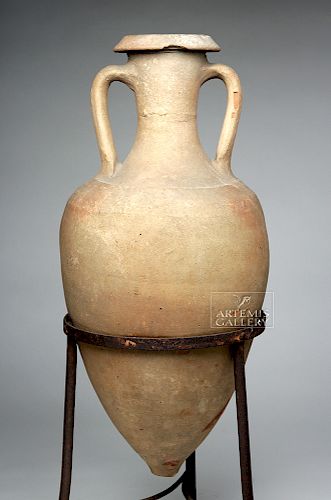Roman Pottery Transport Amphora - Large & Complete
Lot 83
About Seller
Artemis Fine Arts
686 S Taylor Ave, Ste 106
Louisville, CO 80027
United States
Selling antiquities, ancient and ethnographic art online since 1993, Artemis Gallery specializes in Classical Antiquities (Egyptian, Greek, Roman, Near Eastern), Asian, Pre-Columbian, African / Tribal / Oceanographic art. Our extensive inventory includes pottery, stone, metal, wood, glass and textil...Read more
Categories
Estimate:
$6,000 - $9,000
Absentee vs Live bid
Two ways to bid:
- Leave a max absentee bid and the platform will bid on your behalf up to your maximum bid during the live auction.
- Bid live during the auction and your bids will be submitted real-time to the auctioneer.
Bid Increments
| Price | Bid Increment |
|---|---|
| $0 | $25 |
| $300 | $50 |
| $1,000 | $100 |
| $2,000 | $250 |
| $5,000 | $500 |
| $10,000 | $1,000 |
| $20,000 | $2,500 |
| $50,000 | $5,000 |
| $100,000 | $10,000 |
| $200,000 | $20,000 |
About Auction
By Artemis Fine Arts
May 10, 2018
Set Reminder
2018-05-10 10:00:00
2018-05-10 10:00:00
America/New_York
Bidsquare
Bidsquare : Fine Ethnographic / Asian / Ancient Art
https://www.bidsquare.com/auctions/artemis-gallery/fine-ethnographic-asian-ancient-art-3213
Featuring antiquities from around the world including Pre-Columbian, Tribal, Classical, Asian, so much more! Artemis Fine Arts info@artemisgallery.com
Featuring antiquities from around the world including Pre-Columbian, Tribal, Classical, Asian, so much more! Artemis Fine Arts info@artemisgallery.com
- Lot Description
Roman, Imperial Period, ca. 1st to 3rd century CE. A beautiful pottery transport amphora with a conical base, smooth body, tubular neck, collared rim, and a pair of applied handles from just under the rim to the rounded shoulder. The piriform body would have held gallons worth of precious oils used to sustain legions of Roman troops which traveled and settled in most of Western Europe and Britain. The exterior exudes a pale beige earthtone hue. Utilitarian transport vessels like this example were typically not decorated with painted designs or applied details, though some display stamped markings denoting the materials contained in each vessel. Custom museum-quality metal display stand included. Size: 13.5" W x 29.5" H (34.3 cm x 74.9 cm); 36" H (91.4 cm) on included custom stand.
Lacking its cork and pitch stopper, the original contents of this amphora are unknown; based on the globular size and shape, it was most likely used to transport olive oil (smaller ones were for stewed fruit or salted fish, while larger ones were used for wine). Amphorae formed the basis of the Roman economy as storage vessels for transporting goods throughout the Empire, with examples found from North Africa to Britain. The pointed base on this one is standard and was intended for storage in Roman warehouses in soft ground and for transport on ships by placing it through a specially-designed rack and roping it through the handles to others. This vessel likely came from North Africa, a major site of olive oil production (alongside Spain and France) in the Roman economy. This oil was used for cooking, lighting, and, in some cases, bathing; one estimate suggests that each Roman legion consumed 1370 amphorae of olive oil per year!
Provenance: private Davis collection, Houston, Texas, USA; ex-Bonham's London Antiquities Auction, 8 May, 2013, part of lot 84; ex-The Sir Daniel Donohue collection, California, USA. The collection was started by the oil and cement tycoon Daniel Murphy in the 19th century and inherited by his daughter and son-in-law, Sir Daniel Donohue and Countess Bernardine (d. 1968), who then added to the family collection
All items legal to buy/sell under U.S. Statute covering cultural patrimony Code 2600, CHAPTER 14, and are guaranteed to be as described or your money back.
A Certificate of Authenticity will accompany all winning bids.
We ship worldwide and handle all shipping in-house for your convenience.
#132970Most of neck and upper portion of each handle reattached with small amounts of new material and resurfacing along break lines. Surface wear and abrasions commensurate with age and use, with small chips to rim, handles, body, and base. Some small areas of discoloration and light encrustations, otherwise excellent. Nice archaeological deposits, root marks, and light encrustations throughout.Condition
- Shipping Info
-
All shipping is handled in-house for your convenience. Your invoice from Artemis Gallery will include shipping calculation instructions. If in doubt, please inquire BEFORE bidding for estimated shipping costs for individual items.
-
- Buyer's Premium



 EUR
EUR CAD
CAD AUD
AUD GBP
GBP MXN
MXN HKD
HKD CNY
CNY MYR
MYR SEK
SEK SGD
SGD CHF
CHF THB
THB
















